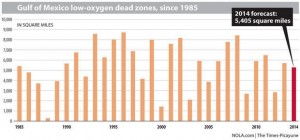Congress should support ‘Waters of the U.S.’ rule
By Chris Macaluso, Center for Marine Fisheries
Theodore Roosevelt Conservation Partnership, Baton Rouge
A recent article in The Times-Picayune detailed the National Oceanic and Atmospheric Administration’s estimate that the dead zone in the Gulf of Mexico this year will be about the size of the state of Connecticut.
Decomposing algae in deep waters depletes oxygen in the lower water column. The fish and shellfish die if they cannot move to areas with more oxygen. These algae blooms are caused by high nutrient levels coming from the Mississippi and Atchafalaya rivers. The bulk of the nutrients causing the dead zone come from farm and urban runoff well upstream of Louisiana. A key fix to limiting nutrients in the Mississippi River and other watersheds across America is in protecting the headwaters and wetlands that can filter nutrients.
Unfortunately, many in Congress are opposing a rule developed by the Environmental Protection Agency and the Corps of Engineers that would make the Mississippi River a healthier waterway. Called the “Waters of theU.S.,” the proposed rule protects critical headwaters, streams and wetlands needed for healthy rivers and lakes, even the Gulf.
A healthy Gulf of Mexico is essential to having a healthy Louisiana. This state’s congressional delegation should be supportive of the laws and rules needed to make our wetlands and waters healthier.

Size of low-oxygen dead zone measured each July along Louisiana’s coast since 1985, in orange. Estimated size of this year’s low-oxygen area, in red, based on the amount of nitrogen carried by the Mississippi River in May, is more than 5,400 square miles. That’s about average, and the same size as the state of Connecticut. (Dan Swenson, NOLA.com | The Times-Picayune)
